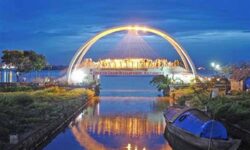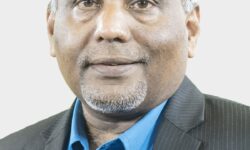KOCHI:
When Pepper House artist-in-residence Anton Kats began his video presentation at a ‘Let’s Talk’ session on Sunday, the audience was first introduced to his grandfather, who was a radio operator during the World War II reconnaissance. Too young to hold a rifle, his grandfather fought against fascism at a mobile radio station instead.
It is this ‘radio connection’ that has shaped the work of the Ukrainian artist-musician, who has been working out of Fort Kochi for the past month as part of the Pepper House residency organized by the Kochi Biennale Foundation.
When he landed in Kochi a month ago, he was surprised to discover geographical and cultural parallels between shipyards at Kherson, where he was born, and Kochi, the largest shipbuilding facility in India. His artistic and intellectual inquiry into the twin worlds of Kherson and Kochi was the basis of his presentation, titled ‘Satellite Island’, which coincided with a display of his multimedia installation at his studio in Pepper House.
‘Satellite Island’ refers to a specific area built around a shipyard in Kherson city, which is home to one of the largest shipbuilding wharfs in Europe. Kats’ presentation looked at the industrial and urban development—and eventual decline—around the shipyard after the collapse of the Soviet Union. His research led him to traces left behind by four ships manufactured for India in Kherson during the 1970s. It was a discovery that served, for Kats, as a major point of a case study into the social and political trajectories of Kherson and Kochi.
The ships were named ‘Vishwa Umang’ (Universal Joy), ‘Vishwa Tarang’ (Universal Desire), ‘Vishwa Abha’ (Universal Grace) and ‘Vishwa Asha’ (Universal Hope).
“These are half-administrative and half-spiritual names that have rather nationalist connotations in terms of the Hindi language and how they have been introduced. Through these ships, on the one hand, I try to unfold the complexity of the Indo-Soviet collaboration, but it is also the complexity of different forms of visions that were particularly developed in the 70s. The materiality of the ships extended to the massive decay of the production, decay of infrastructure, whether it is human or material,” Kats said in his presentation.
Having grown up on war stories narrated by his grandfather from the perspective of a radio operator, Kats’ interventions as a Pepper House artist-in-residence have been informed by methodologies of radio narrowcasting and sound spaces.
His work explored the building blocks of ‘communist desires’, with its myriad narratives of hope, loss and alienation, especially with respect to worker unions. Samples of ocean waves, sonic frequencies, and stories about ships travelling through physical and radio-wave distance were all elements of Kats’ unique presentation.
Kats’ residency in India has been supported by HCL Foundation, as well as the bangaloREsidency programme of the Goethe-Institut/Max-Mueller Bhavan. In addition to ‘Satellite Island’, Kats is focusing on a larger theme of ‘Bridges Without Rivers’– his response to a tendency that he observed among many artists, politicians, and other practitioners, who tend to forcefully ‘build bridges’ between lands and concepts for the purposes of their own work and personal interests. Instead, Kats hopes to see connections and patterns without forcefully imposing his ideas as the truth.
Berlin-based Kats is a multi-disciplinary artist, whose work involves sculptures, musical compositions and concerts, learning sites, public programs, including elements of video, sound, research and dance. He has been awarded a practice-based doctorate from Goldsmiths, University of London. His works have been exhibited and performed at The Serpentine Galleries, Tate Modern, Tate Britain, the 10th Berlin Biennale, Victoria and Albert Museum, The Showroom gallery, and at documenta14.
Anton Kats’ installation was displayed at Open Studio at Pepper House, Fort Kochi, from September 22-23. His work will be re-interpreted and installed during the Kochi-Muziris Biennale, which runs from December 12, 2018 to 29 March, 2019.




